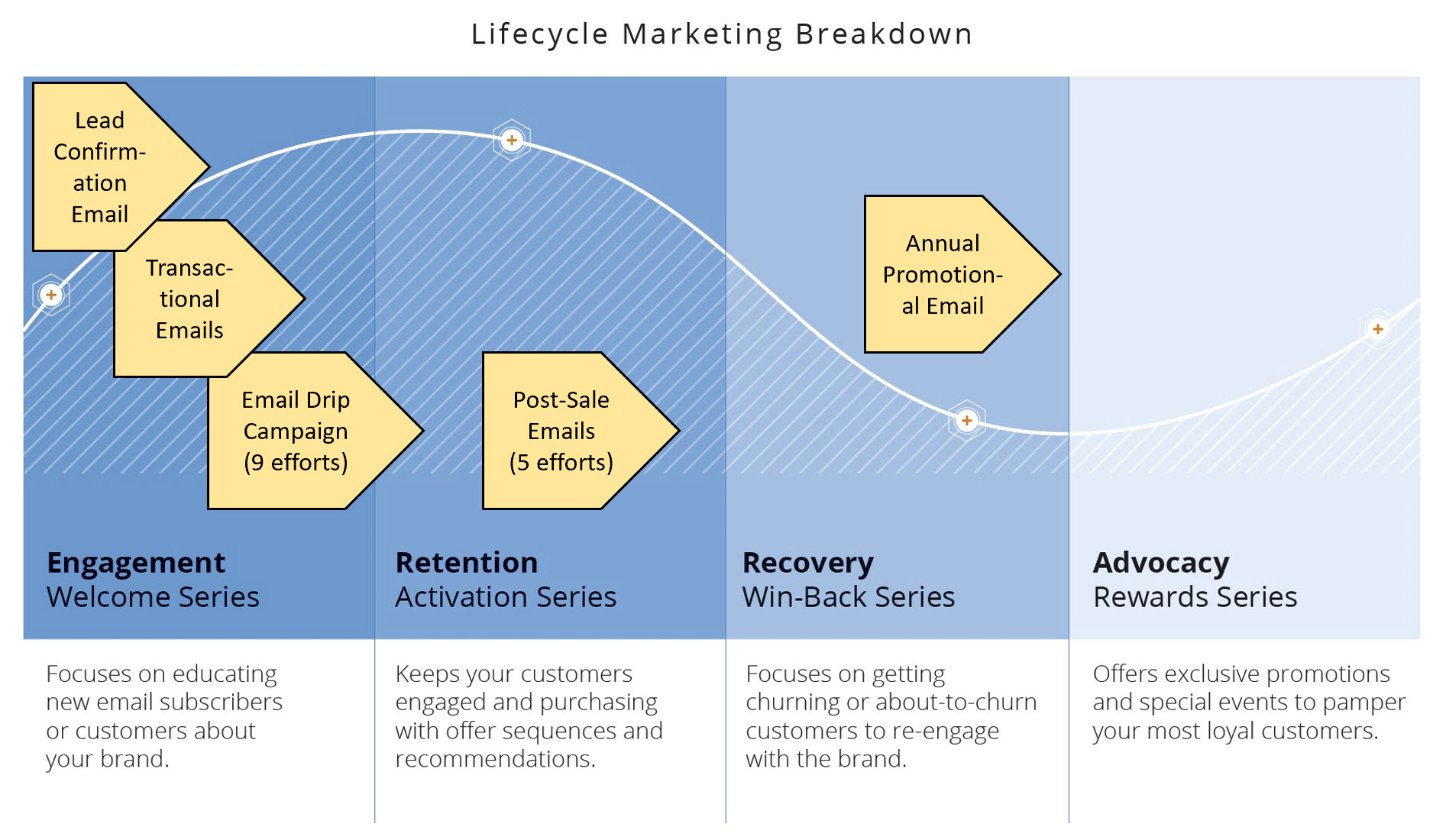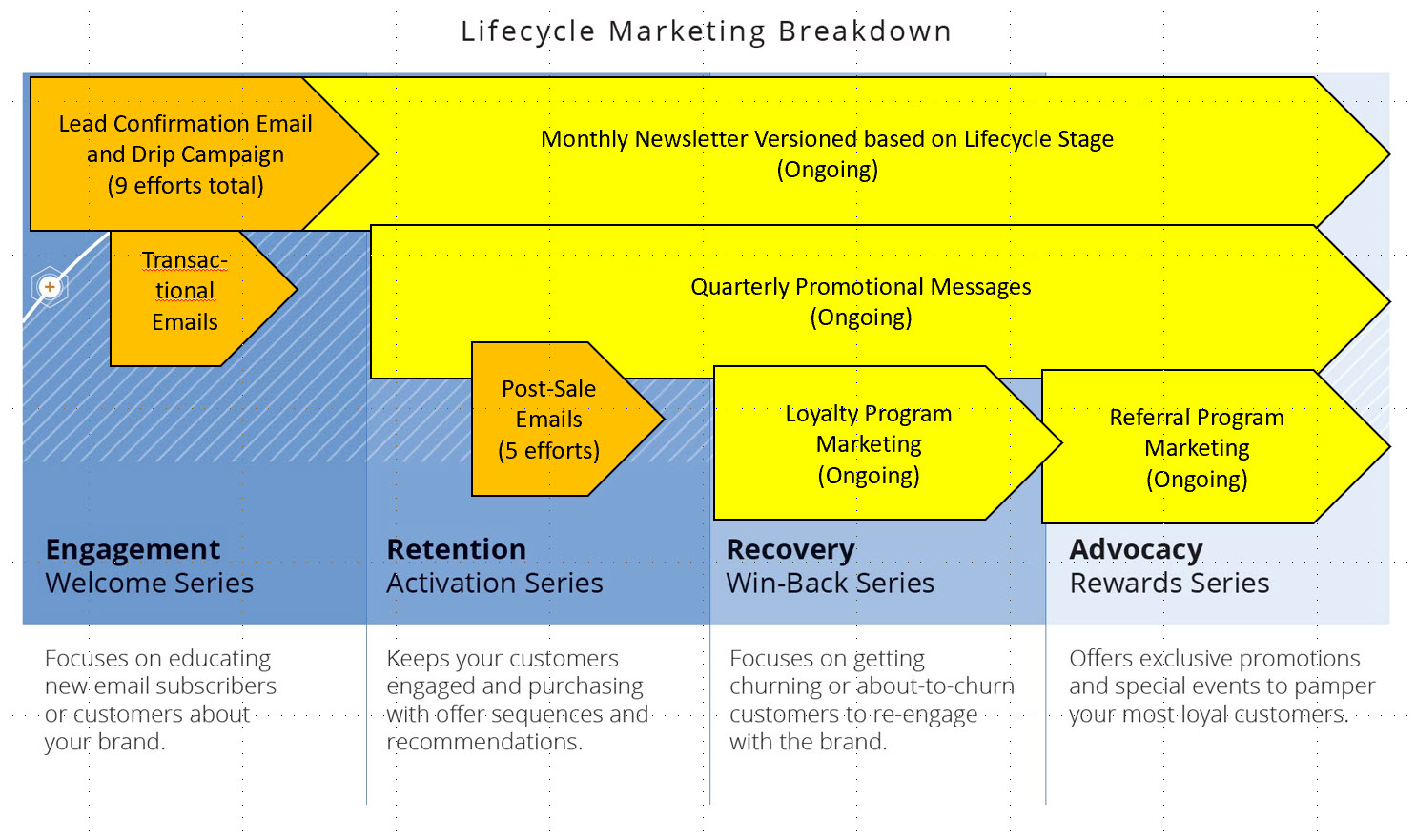Does Your Email Marketing Program Align With Your Customer Lifecycle?
How well does your email marketing program align with your customers’ lifecycle? Put another way, are you practicing lifecycle marketing?
If you’re not sure or if you’re wondering if you could do better, this blog post is for you. We’re going to talk about:
- Why align your email marketing campaigns with your customer lifecycle?
- Ways to boost the quantity and quality of your lifecycle messaging.
- How to build a new or improve an existing email lifecycle marketing program for your organization?
Try Userpilot Now
See Why 1,000+ Teams Choose Userpilot

Why practice lifecycle marketing?
So why is this important? Because it’s one measure of relevance. If you can understand and speak to where your prospect or customer is in their relationship with your brand and/or your product (the lifecycle), your messages will be more relevant to them.
Lifecycle marketing can also help you move people more quickly through some lifecycle stages, to get them to the stages where they purchase sooner.
Customer lifecycle models
In order to align your marketing program with your prospect/customer lifecycle, you need to have a lifecycle model. Lifecycle models are typically less detailed than customer journeys, focusing on stages rather than specific actions. You typically begin with a lifecycle model and then build more granular journeys on top of it.
One of the lifecycle models I frequently use with my clients is the ERRA model, which stands for Engagement, Retention, Recovery, and Advocacy.
This is a simple but effective structure to use when your business model includes repeat purchases or actions; I’ve applied it to clients in the financial services, membership, SaaS, and other industries. It works in the B2B realm just as well as it works in the B2C realm.

One reason this model is useful is that it’s not linear. Some customers may move through the four stages in order and then settle in the final stage. But other customers can move back and forth through the four stages and then return to either retention or recovery. Some may move through the first three stages, settle at retention, and never reach the advocacy stage.
All your customers will move through these stages (or whatever stages your lifecycle model includes) at their own pace, meaning that you need to customize your program based on stage, not just time. This is where email messages triggered by specific actions, not just time, become invaluable to your program.
Evaluating your current program against your lifecycle model
Your first step, once you’ve chosen a lifecycle model, should be to overlay your marketing communications on it and see where they fall.
Think about who the message is targeted to, then identify which stage of the lifecycle these prospects or customers are in.
Here’s an example from some recent work I did for a client.

This client provides consumer services, and this is what their email marketing looked like when I got there. Notice anything? Most of the email marketing takes place in the ‘Engagement’ phase. There’s not a lot happening in the ‘Retention’ and ‘Recovery’ phases, and nothing is going on in the ‘Advocacy’ stage.
It is usually less expensive to retain a customer than it is to find a new one. That’s where the marketing program in its current state is falling down. There’s very limited communication post-sale.
What does your overlay of marketing campaigns on your lifecycle model look like? If your communications are light or non-existent in one or more stages, time to make a plan.
Where to start on a plan?
There are some simple but effective tools you can use to quickly cover all your lifecycle stages. Here are four of them.
1. Email newsletter with dynamic content
A newsletter doesn’t mean it has to be long or complicated. But it does need to include some editorial content and promotional content.
If you choose the editorial content to have broad appeal to your audience, regardless of their stage in the lifecycle, you can then use dynamic content to tailor the promotional content specifically to the lifecycle stage.
Put this in place, and you instantly get regular communication at each stage of your lifecycle model.
2. Promotional schedule
Regular promotions to your list are important, but they can often fall between the cracks if you don’t have a plan. Decide how often you want to offer special deals to your list and then put together a calendar, including send dates and when you need to start on the creative.
Think through how the promotional schedule will work with your lifecycle model. Sometimes you will want to offer the same special deal ($1,500 off) to your entire audience, but change the positioning based on their lifecycle model (try our service versus use our service again versus tell your friends about our service). At other times, you might offer different promotions to people at various stages of the lifecycle.
3. Quality content
Just because you have an email going out to people in the ‘Retention’ stage of the lifecycle doesn’t mean it’s effective. Take a look at each email message you are sending and ask yourself:
- Why are we sending this? What business goal (qualitative or quantitative) do we hope it will help us achieve?
- Does the content of this message support that business goal? Does it make the case and overcome any objections for the action you’re requesting?
- Is there anything we might do to make this email more effective at meeting its business goal? Think in terms of copy and design, but also timing, segmentation, and other factors.
4. Automation
Setting up automated triggered emails is one of the quickest ways to cover your lifecycle stages with marketing campaigns, especially if you are short-staffed and already struggling to get your campaigns out.
Setting up triggered messages, based on actions that happen within each lifecycle stage, helps you deliver what people want to read when they need to read it.
But don’t get sloppy. It’s better to launch one well-thought-out campaign for one stage than to throw together triggered messages for each stage of your lifecycle without a plan.
Automation can help you extend the life of your successful campaigns; it can’t turn unsuccessful campaigns into winners.
When are you done?
Truly, you’re never really done. There will always be more campaigns you can add, more ideas for optimizing the campaigns you’re already running, and reasons to sunset campaigns that have outlived their usefulness.
That said, here’s what an initial lifecycle marketing plan might look like.

The bright yellow highlights new campaigns to be developed. The orange represents existing campaigns that we’re modifying to improve engagement and response, via message maps, copy, design, or other means. We’re a few months into the process, but we should have all this in place a few months from now. And then we’ll see what else we can do to boost performance.
Conclusion
Look and see how your email marketing aligns with your customer lifecycle. See where there are gaps and where existing messages can be improved, and let me know how it goes!




